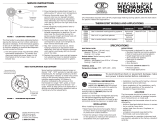
1
MODELS
500 1 HEAT/1 COOL
505 HEAT ONLY
USER MANUAL
Builder Series
Mercury-Free Mechanical Thermostats
with the Exclusive Megaswitch
®
Magnetic Switch Technology
Compatible with low voltage, single stage gas, oil or electric heating or
cooling systems. Model 500 can be used with single stage heat pumps.
Models 500 & 505 can also be used on 250mv to 750mv millivolt heat only
systems. Do not use on applications with voltages above 30 Volts AC.
READ ALL INSTRUCTIONS BEFORE PROCEEDING
WARNING!
Important Safety
Information
• Always turn off power to air conditioning or heating system prior to installing, removing cleaning or servicing thermostat.
• Read this manual thoroughly prior to installing or operating this thermostat.
• This thermostat is designed for use with 24 Volt-AC low voltage single stage gas, oil or electric heating or cooling systems,
including single stage heat pumps (Model 500 only). This thermostat can also be used on 250mv to 750mv millivolt heating
only systems (Models 500 and 505).
• Do not use this thermostat on applications with voltage above 30 Volts AC.
• The system must have 24 Volt AC present for proper system operation and control.
• Wiring must conform to all building codes and ordinances as required by local and national code authorities
having jurisdiction.
• Do not short (or jumper) across terminals on the gas valve or at the heating or cooling system control board to test the
thermostat installation. This could damage the thermostat and void the warranty.
• Do not select COOL mode of operation if the outside temperature is below 50° F (10° C). This could possibly damage the
controlled cooling system and may cause personal injury.
• This thermostat should only be used as described in this manual. Any other use is not recommended and will void warranty.
SPECIFICATIONS
1
• Electrical Rating: 24 Volt AC (18-30 Volt AC), 250 – 750 millivolts
• Heat Anticipation: 0.15 to 1.2 amps.
• Temperature Range: 50° - 90° F (10° - 32° C)
Old Terminal New Terminal Terminal Description
V or Rc Rc Cooling Transformer
M, 4, Rh or R Rh Heating Transformer
O O Reversing Valve (Cooling)
B B Reversing Valve (Heating)
Y Y Cooling or Compressor for HP system
H, W or 4 W Heating Control
G or F G Fan Control
INSTALLATION
2
1. Always turn off power to the air conditioning or heating system prior to removing existing thermostat.
2. Remove the cover of old thermostat and locate wire terminals. Do not remove wires from terminals yet.
3. Label wires prior to removal from terminals. Use chart below to determine new terminal designations for new thermostat.
2.1
Replacing Existing Thermostat
2.2
Installing Your New Thermostat
NOTE: This thermostat is designed for use with a 24 Volt AC low voltage single stage gas, oil or electric heating or cooling
systems, including single stage heat pumps (Model 500 only). This thermostat can also be used on 250mv to 750mv millivolt
heating only systems (Models 500 and 505). Do not use this thermostat on applications with voltages above 30 Volts AC.
1. Always turn off power to the air conditioning or heating system prior to installing new thermostat.
2. Place system lever to OFF position, and fan control lever to AUTO position.
3. Remove the front cover of the thermostat by firmly pulling it away from the base.
4. Place thermostat base against wall in the desired thermostat location and guide thermostat wires through
vertical slot in base.
5. Mark placement of mounting holes as appropriate and drill using a 3/16” drill bit.
6. Gently tap supplied plastic anchors into the holes in the wall.
7. Place the thermostat base against the wall in the desired location making sure the mounting holes are aligned and the
thermostat wires are properly inserted through the slotted opening in the base.
NOTE: If installing this thermostat in a new installation, be sure to locate the thermostat about 4 to 5 feet above the
floor in accordance with applicable building codes. Be sure to install thermostat in a location that provides good airflow
characteristics and avoid areas behind doors, near corners, air vents, direct sunlight or near any heat generating device.
Installation in any of these areas could impact thermostat performance.
8. Fasten the base to wall using supplied screws.
9. Connect wires to proper terminal screws using new terminal designations (see Wiring Diagrams section of manual).
10. Make sure all of the wire connections are secure and are not touching any other terminal to prevent electrical shorts
and potential damage to the thermostat.
11. Locate the internal fan option jumper, HG (Gas) or HE (Elec) on the base (Model 500 only). This jumper controls the
heating system fan delay. Insert the jumper over the pins labeled HG for gas or oil fired systems. This will allow the
furnace to run for a few seconds before the fan starts. Insert the jumper over the pins labeled HE for electric
systems with electric furnace elements or heat pump systems that require the fan to come on immediately.
12. Attach front cover of thermostat to base of the thermostat by pressing it onto the four corner posts of base.
13. Restore system power so you can test installation.
4. After labeling and removing all wires from terminals, unscrew the existing thermostat mounting base from wall. Be sure
to secure wires to prevent them from slipping back into the hole in the wall.





